Make a Handle
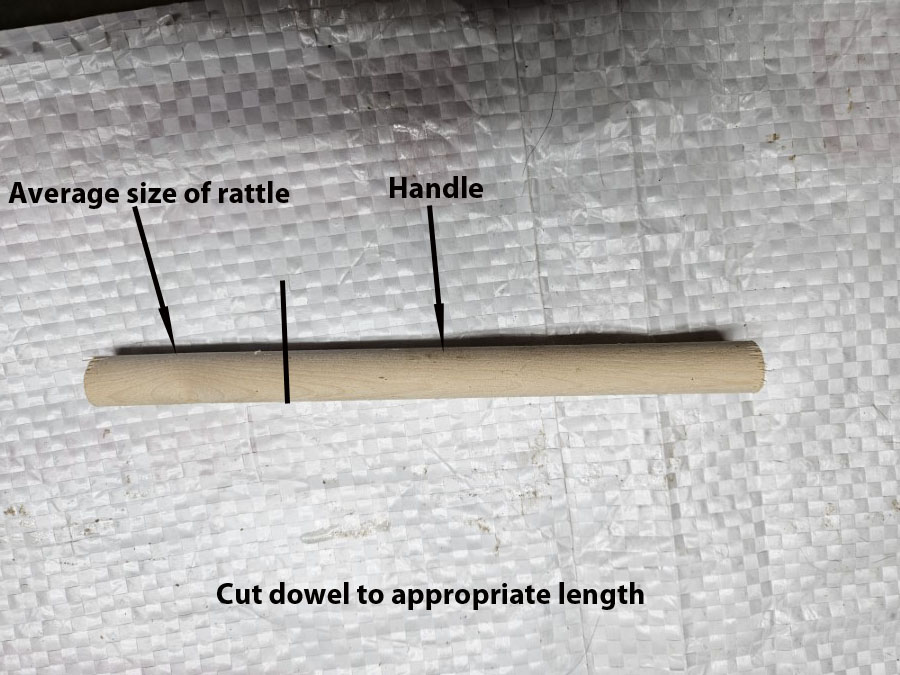
From an antler or cutoffs from other projects cut the heads that are appropriate to the size of the stem.

Drill 3/8″ hole with the bit angled slightly upward. This is important because if the stem hole is angled downward, the pipe will not apppear normal.

Drill the top hole using any bit close to the antler core size. Try to just go through the stem hole and not through the stem hole. (This is better for attaching the stem.) Ream the hole out as far as possible.

Get the head looking like you want it to look like when finished. This is much easier to do now.
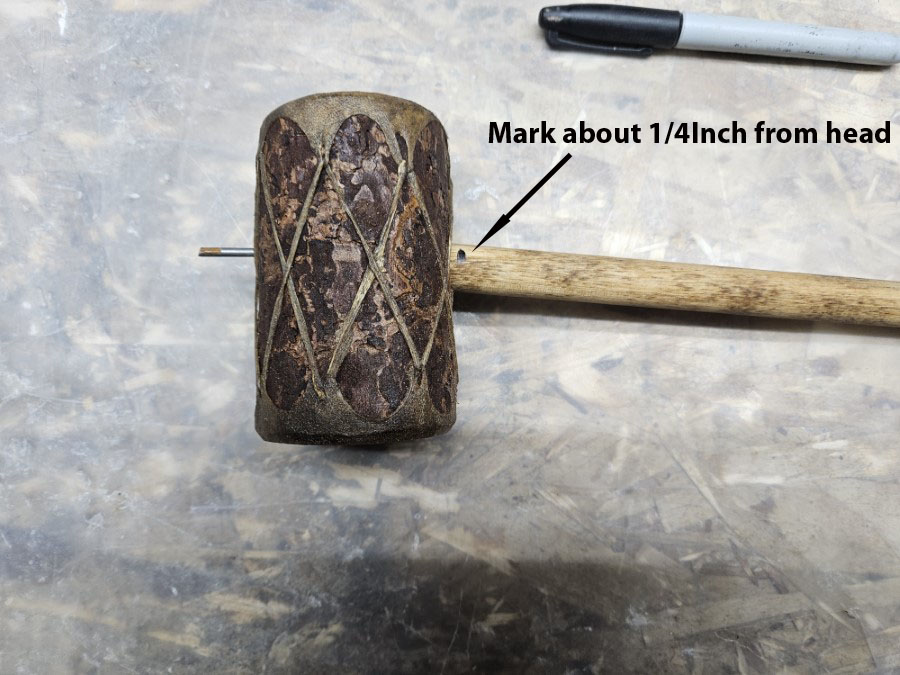
This is used to attach the head to the stem

Drill the stem (Pipe End) to 25/64″ . If you don’t have that bit use a 3/8″ bit and wobble it out as needed when attaching head.

Put the end of the tubing in the pipe just barely through the antler wall. Measure and mark 1 1/2- 2 ” out.
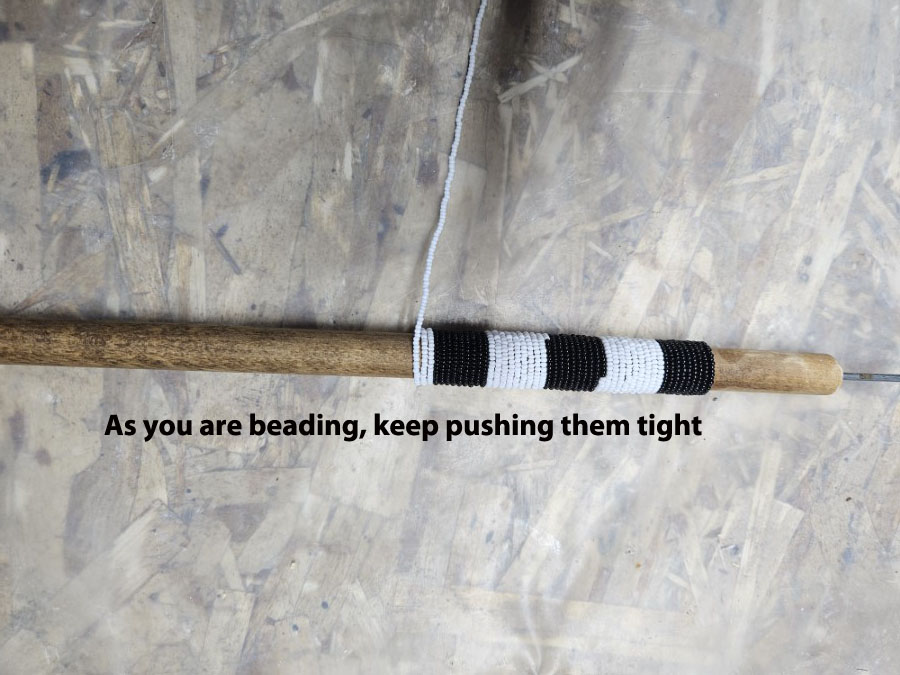
Using a tubing cutter, cut the tubing at the mark.
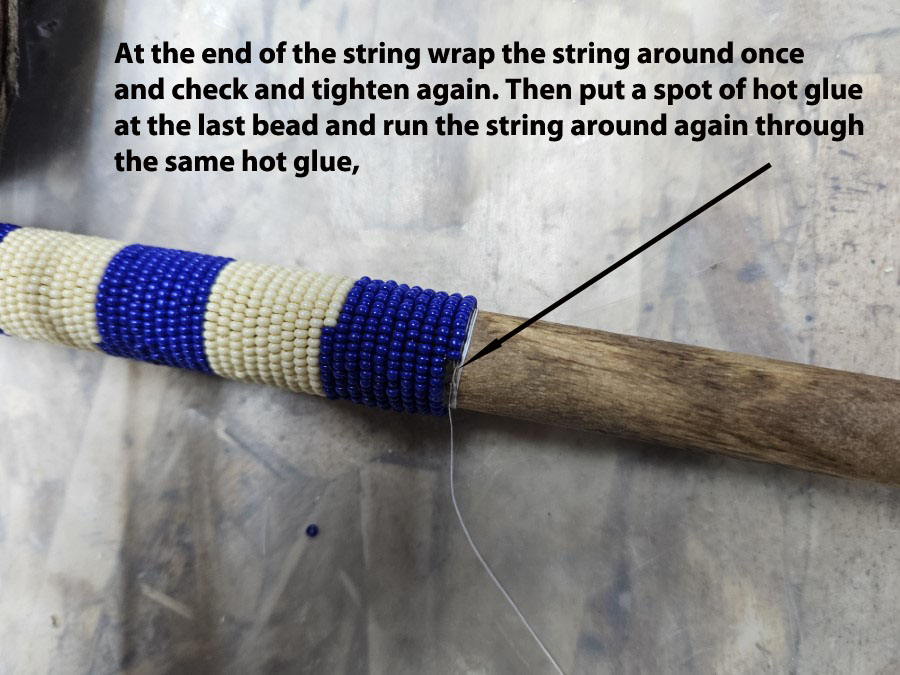
Using super glue or similar coat the end of the tubing and inside the stem hole. Insert the tubing and glue in place. ( The tubing in the image is in too far…just through the wall.)
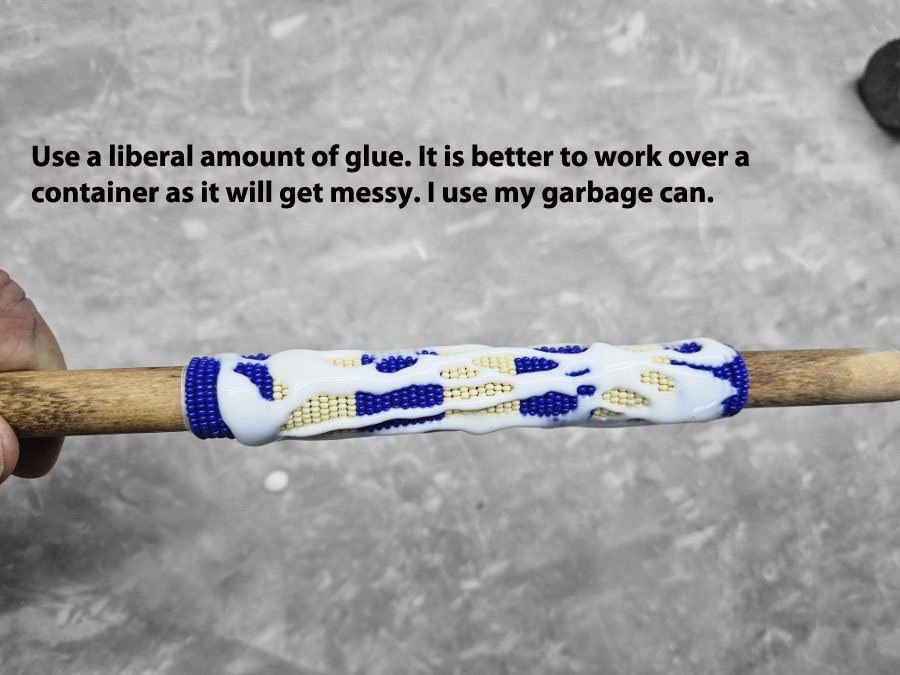
Insert the head into the stem. Test before gluing to be sure the stem will go all the way to the head. If you used a 3/8″ bit, you may need to ream out the hole some. You can use super glue or Gorilla glue. This is the weak point of the pipe, so be sure it is secure. OR you can wait until the pipe is beaded and sewn.
***It is easier to sew and bead without the head attached, but keep the head and stem together so they attach correctly. (If you are doing a lot of pipes this is hard to do.)
Build The Pipe
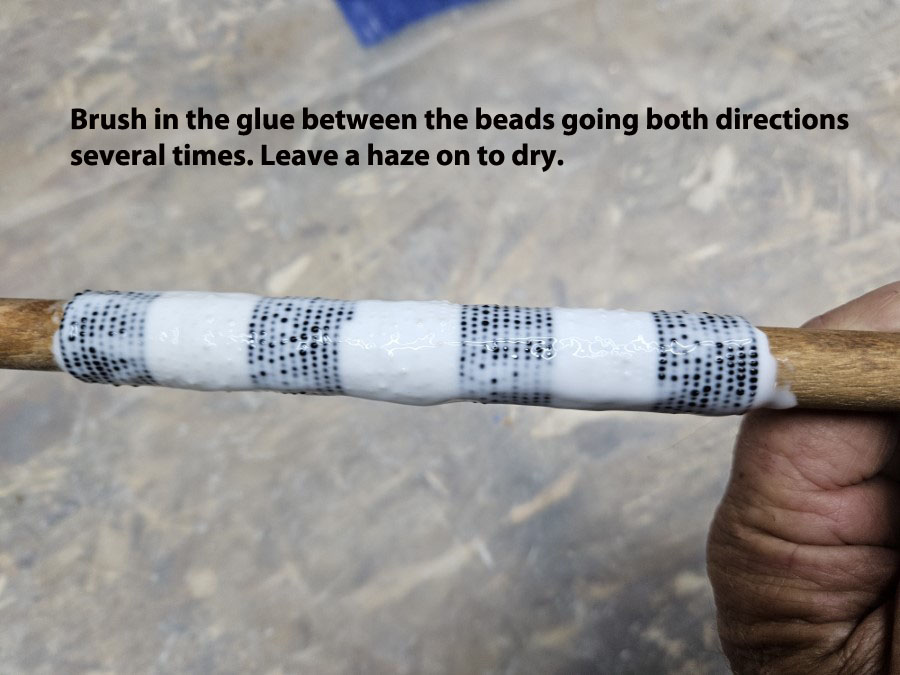
This is a good time to paint or burn the bowls.
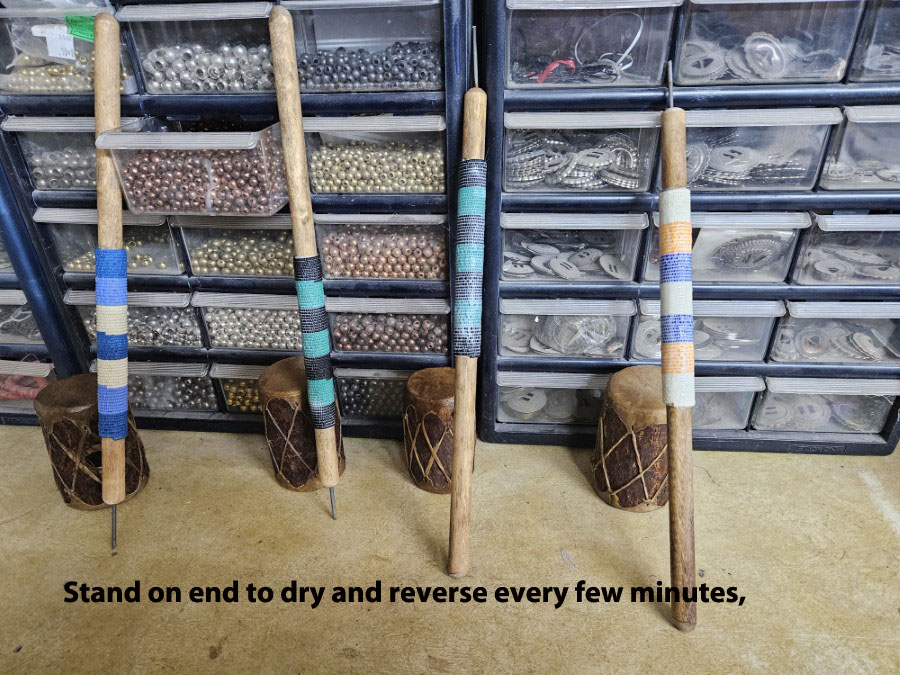
Here is where you can spray or paint the heads with clear flat laquer. Also, if you are going to use a coat of epoxy resin, this is when to do it. This is not necessary. I do it mainly to strengthen the connection of the head to the stem.
Sewing the Rawhide

Measuring the circumference is very important step. If it is not accurate the rawhide you cut will be wrong. On tapered stems this requires 2 measurements, one at each end or the length of the rawhide.

This measurement must be very close to the end of the rawhide strip. In this case, I am using 5 1/2″ strips so the measurements should be 5 1/2″apart.

Add 1/4″ to 3/8″ to each measurement 1/4: for thin and 3/8″ for thicker rawhide (over 1/16″) This is a general thing and may vary some with any piece of rawhide.

You will need a metal straightedge, a good utility knife, ruler, a hard cutting board, and a stone. It is a good idea to touch up the utility knife every cut or two. This is especially true when cutting thicker rawhide. Also, a long straightedge for trimming a hide and a shorter one for cutting the strips. Like anything, just make do with what you have.

Starting with a hide, it is important to trim one side going down the length of the hide. I usually trim off the end that will have the least waste. See the next picture.

Then trim one end of the Hide across the grain.

Now measure and cut a piece using the length of the strips you want. (Here I am going to use 5″ lengths.) If you are doing several pipes you can repeat this as many times as needed. Measure the circumference of largest pipe you see (on the large end) to get an idea of how many strips you will get out of each piece. Be sure to measure both ends of the cut.

Since pipe stems are tapered, the srtrip you are going to cut needs to be cut at a small angle. This important to help keep the stitching straight. The image is exaggerated, but you get the idea.

Using the measurements from the stem cut a strip out.

Before you start to punch holes, test the piece around the stem. If it just touches 1/8″ in is plenty. Fudge a little on both sides in or out if needed. This will come easier as you do more, as it is mostly experience here. It depends entirely on the thickness of the hide. This is an 8 hole chisel punch which is about right for most work.

Cut a much longer piece of senew that you need. You may need a long tail on the end and you don’t want to run out before you are done. (I am using ABOUT 30″ here.) Thread a curved needle (A straight needle does not work very well) and you are ready to start.

Start your first stitch from the inside.

Now go through both end holes and start stitching down keeping the tail between the stitches.

Go down 2-3 stitches with the tail on top of your needle as you go through each stitch. Then hold the tail outside and stitch the rest of the piece. Then give the tail a good pullto keep end stitches tight and lock in the end.

Make the last stitch twice. This will lock it in well enough. Don’t cut it off. Just tug it tight. Leaving the tails on gives you some options if when dry the stitches are loose, you can take you needle and working toward the endspull each stitch tight then at the end you can pull the slack out using the tails. Loose stitches are caused by not pulling stitches tight, cutting the strip too wide and the rawhide doesn’t stretch enoughor holes not cut far enough in.

This is an alternative that can be used on thinner hide.

If the stitching is not straight, when you finish pull it straight with the tail, take a few wraps and a half hitch. It MAY help.

When dry, if the tails aren’t needed, just clip them off as close as possible. Here I add a drop of super glue to th end holes for insurance,
Beading

You will need a water based glue that dries clear and a flat brush. (Elmer’s etc.) I like to use size 11 Rocaille Seed Beads for smaller circumference projects, but size 10 will work. A glue gun is very handy.

Lay out a pattern you want. I always use an odd number, but any way you want to do it is fine. It is a good idea to keep in mind what colors of crow beads you want to use later for decorating.

On the end strand add a spot of hot glue. Dip it in water to set the glue.

Tie the ends together using a square knot (VERY IMPORTANT). Test each knot to be sure it won’t slip.

Hold the end of the starting strand down an smear a small ammount of hot glue on the stem about 1/8″ from the end of the rawhide. Then using the side of the tip smear glue around to hold the end down. The glue must be flat on the surface so the beads lay flat.

Keep the beads on the strand together letting them slip gently through your hand ad you wrap them.

As you finish a strand keep pushing and straightening the rows. Be careful not to run the beads back over the knots. Because if the knot rolls over it becomes 2 half hitches and will slip. If this happens the beads will come off and you have to replace the strand.

Once the pattern is all wrapped once again straighten and push beads together. Then wrap the tail around a couple times and add a spot of hot glue to the end.

If your brush has been in water, dry it on a rag before ading glue. You don’t want the glue to dilute.

Adding the glue is messy, so I do it oner a garbag can. As you squeeze glue on, keep rotating the stem. Be liberal with the glue.

Brush the glue on going up and down and the around the stem. If there is excess brush off. If there is not glue on the surface add more. You will get the feel of this after doing a few.

Stand pipe on end a few minutes.

Reverse the pipe to even out the glue. Repeat this 2 or 3 times.

Add next section of rawhide. Be careful to leave a small gap and keep water from the rawhide off beads. As the rawhide dries, it will pull the beads apart.
Repeat this for each bead and rawhide section.
Putting a mouthpiece on is optional. It is very time consuming and hard if you don’t have a belt sander or disk sander.

If you want a mouthpiece you would do it here. Sand or cut the tapered part of the end of the stem flat. Find a piece of antler that is close to the same size as the end of the stem. This is not necessary, but is a nice finish to the end.

Drill 1/4″ hole on mouthpiece and stem. Then drill a 3/16″ in the end.

Rotate the mouthpiece for best fit and a natural look and superglue tubing and mouthpiece on.

Sand the surfaces to meet.

Now the ends are ready for the end piece of rawhide.

Sew the last piece of rawhide on overlapping on the antler about 1/2″. If not using a mouthpiece, cut rawhide about 1/2″ from the end of stem.

Antiquing should be done here if you choose to do it. (This is not necessary depending on how you want the end pipe to look.) Use a dark stain applied carefully. Allow to dry for 30 – 60 minutes. When tacky carefully highlight. Try to keep the stitching pointed down to avoid stain running under the rawhide.
Decorating

Putting ties at ends on beading will hide the gaps that occur from shrinkage. I cut pigskin strips and stain with diluted stain and dried 1 day at least. Whatever you have will work as long as it blends in. If you did not antique, you can use buckskin or about anything you choose.

Here I am using sinew to do the decorating so I can use hairpipe, spacers. and metal beads where I want. You can do it with lace, goat thong also but you are limited to only beads and must use larger cones. It just whatever you have and prefer.
In any case, do not cutoff tails until the glue used is set. Test every attachment before you cut and if the feather or horsehair comes loose you can fix it.
The next 3 only apply if you are doing a large number of pipes. It saves going back and forth.
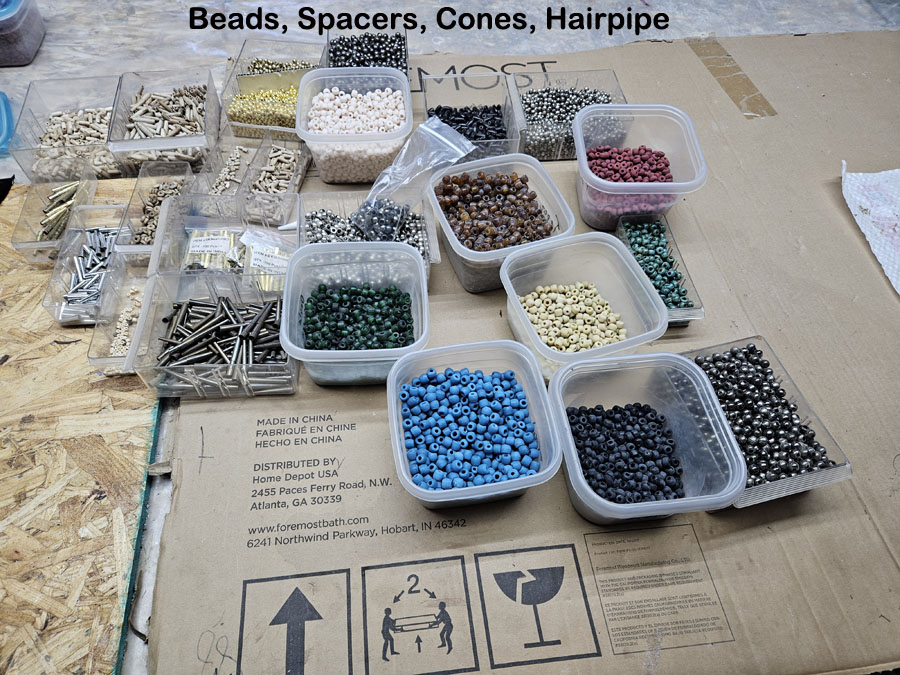
Gather needed materials….beads, cones, hairpipe, spacers etc.

Cut horsehair to length.

Select appropriate size feathers. This can vary depnding on what you have available.

You end up with something like this. There many ways to do this. This is just one.
